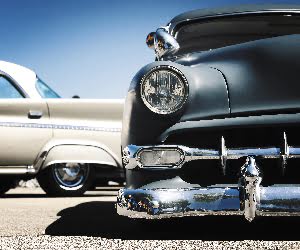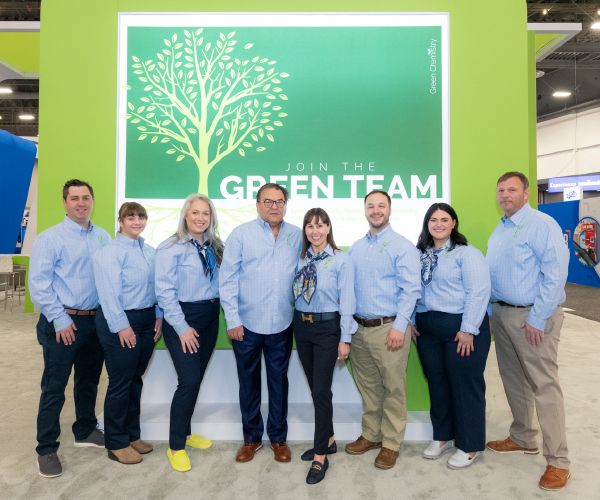
Blast from the Past - Fall 2014
July 2, 2014
5 minute ReadWe occasionally provide excerpts from The Great American Car Wash Story. Former ICA Executive Director Gus Trantham and veteran commercial writer John Beck wrote this book in 1994. It represents the most complete history we have found of the industry in North America. Enjoy.
Chapter 20
MITTING BAYS: THE SECRET INGREDIENT
It may not be fair to call the mitters the “secret” to the success of car washing. It was certainly a “solution” to early problems, and it did help to pioneer car washing on its way to becoming a new industry.
But it wasn’t a secret.
How could you keep secret a small army of men attired in boots and rubber aprons, wielding big mitting gloves and sudsy sponges all over the bodies of cars in the very heart of the tunnel as the cars emerged from under a brush arch into the mitting bay? This bay was flanked with long trays filled with sudsy solutions for the mitters to dip into with dripping sweeps as they grinned and gossiped across the hoods and roofs of the cars as they glided down steadily toward the rinse arches that flooded away the suds in torrents of clear water.
Actually, there was no way to keep this a secret because the more imaginative of the car wash operators provided walkways down the length of the car wash and generous windows through which customers could view their cars being treated like queens of the road in their own not-too-secret health spas. That was one of the “funs” of patronizing the car wash!
Contrary to what some of us may believe, many of these mitting teams really enjoyed their work, shouting their own private bon mots to each other between suds-swipes and frequently grinning and waving at the customers peering at them through the glass.
Unless you’ve watched an experienced mitting team, you can’t appreciate the kind of skill necessary to complete the work in a matter of the few seconds a car would be passing through the mitting bay. Dave Lippitt expressed it well when he said: “A mitting job, well done, is a joy and a delight in movement and rhythm.”
Too bad this skill became obsolete before some choreographer made a ballet out of it!
One thing is certain. These mitting teams played a vital role in car washing over the first few decades of the business. Jack Flapan recollects using as many as 40 employees over a weekend to wash as many as 1,000 cars a day, most of the workers being mitters. As he recalled:
“We used rock island sponges to carry the soapy water. Once we experimented by rubbing kerosene on the cars before putting them through the washing cycle. We charged $1.25 per car and paid the workers $1.25 a day plus 2 cents per car washed.”
Labor for only $1.25 a day? This gives you an idea how early Jack entered the car wash business, and why it was possible to hire such big teams of mitters. Willing labor simply wasn’t too much of a problem back then.
As Abe Bell recalls, his usual crew was nine men, but that this would climb to 40 people on busy days. He had an arrangement with an employment agency that could send him a taxi full of workers on an hours notice. Abe recollects:
“In 1946 the minimum wage was 35 cents an hour, but we paid 75 cents. Our price was $1.75 for a regular wash plus 25 cents extra for whitewalls because we cleaned them by hand with steel wool pads.”
Paul Hurwitz had received his initiation into car washing in 1935 working his way through Carnegie Tech in Pittsburgh. He washed cars with bucket and sponge at what was considered to be the world’s most progressive gasoline service station. Everything seemed to be automated, except car washing. He recalled, when describing his chain of car washes in the Philadelphia area:
“In the beginning, you couldn’t wash the old design cars properly without the help of mitters. There were too many hard-to-reach curves, running boards, and such things as rear mirrors and radiator caps. One week we had as many as 1,000 men on our payroll and would wash up to 200 cars an hour at an average of 2.2 cars per man-hour. Most of our employees were black and they were consistently very good workers. At one dual tunnel car wash we would have as many as two dozen finishing men to dry the cars.”
It might be asked: “What were these things called mitts?”
Irving Rice, of Rice Enterprises, is one of the pioneer distributors of car wash supplies going back as far as 1949 and was a supplier of such mitts. As Irv described them:
“These mitts we sold were actually large gloves made of sheep skin faced with the natural wool. They would pick up the sudsy water out of the mitting trays and make possible an easy sweep from the trays over to the passing car. With one of these on each hand, a man could quickly cover a wet car surface. And because they were always dipped into fresh solutions they never had to be washed the way drying towels have to be cleaned and dried.”
How long did these mitting bay operations continue?
Especially in view of the gradual appearance of the words “labor shortages” and the high cost of manual operations? In 1966, David Lippitt conducted a survey on the utilization of brush equipment and mitting techniques, and in his conclusions had this to say:
“Even more important than brush units, is the mitting process. True, a number of new car wash installations are boasting ‘absolutely no mitters’, but not one of these car washes answered our survey. Most of these operations are finding tough sledding, and as many have been failures as have been successes. Could it have been the lack of manpower that kept them from answering our surveys?”
“The mitting process then apparently is still with us. In response to one question, ‘Do your mitters skip parts of the car adequately covered by brushes’ we received almost a 50- 50 split. While 48 percent did skip, 52 percent covered the entire car. So the car is still largely washed by hand. Brushes, pressure rinses help, but the final answer is in the hand mitting.”
“Mitting is perhaps the wrong word to use to describe this hand operation as we found out from the returns of this survey. But through usage over the years, mitting it’s called and mitting it remains. I doubt that I could coin a better or more acceptable word, term or phrase. The reason I’m reluctant to use mitter is that brushes, pressure spray guns and even towels are used by some operators. And in some cases mitts are not listed at all.”
Today, it may well be that mitting is an obsolete skill. Yet the mushroom growth of car detailing, where so much of the work is being done by hand, may well revive the use of mitting techniques. We might even see the day when the ballet ‘’Miracle of Mitting in the Mystical Carwash’’ may see its debut on Broadway. After all, we have a musical about cats, why not the cat’s pajamas of the car wash?








